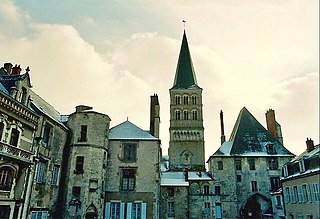
Northampton is a market town and civil parish in the East Midlands region of England. It lies on the River Nene, 60 miles (97 km) north-west of London and 50 miles (80 km) south-east of Birmingham. As the county town of Northamptonshire, Northampton is the largest settlement within the unitary authority of West Northamptonshire. Northampton is one of the largest towns in England; it had a population of 212,100 at the 2011 census.

Earl of Huntingdon is a title which has been created several times in the Peerage of England. The medieval title was associated with the ruling house of Scotland.

Earl of Northampton is a title in the Peerage of England that has been created five times.
Maud, Countess of Huntingdon, or Matilda, was Queen of Scotland as the wife of King David I. She was the great-niece of William the Conqueror and the granddaughter of Earl Siward.
Gilbert de Gant, 1st Earl of Lincoln was an English nobleman who fought for King Stephen during The Anarchy.

Wenlock Priory, or St Milburga's Priory, is a ruined 12th-century monastery, located in Much Wenlock, Shropshire, at grid reference SJ625001. Roger de Montgomery re-founded the Priory as a Cluniac house between 1079 and 1082, on the site of an earlier 7th-century monastery. In 1101 bones, believed to be those of Saint Milburga, were discovered beneath the floor of the old church. The relics were ceremoniously translated to the main monastery church.

La Charité-sur-Loire is a commune in the Nièvre department and Bourgogne-Franche-Comté region of eastern France.

Delapré Abbey is an English neo-classical mansion in Northamptonshire.
Simon I de Senlis, 1st Earl of Northampton and 2nd Earl of Huntingdonjure uxoris was a Norman nobleman.

Lewes Priory is a part-demolished medieval Cluniac priory in Lewes, East Sussex in the United Kingdom. The ruins have been designated a Grade I listed building.
Simon II de Senlis, 4th Earl of the Honour of Huntingdon and Northampton was an Anglo-Norman nobleman. He was the son of Simon I de Senlis, Earl of Huntingdon-Northampton and Maud, Countess of Huntingdon. He married Isabel, daughter of Robert de Beaumont, 2nd Earl of Leicester and they had a son Simon.

In the Middle Ages, from the 11th century, the Cluniac order established a number of religious houses in the kingdoms of England and Scotland.

Piddington is a village and civil parish about 4.5 miles (7 km) southeast of Bicester in Oxfordshire, England. It lies close to the border with Buckinghamshire. Its toponym has been attributed to the Old English Pyda's tun. The 2011 Census recorded the parish's population as 370.

Roger fitzReinfrid was a medieval English sheriff and royal justice.
Daventry Priory was a priory in Daventry, Northamptonshire, England.
Francis Lockier, BD was the first dean of Peterborough.
Simon III de Senlis, Earl of Huntingdon and Northampton was an English nobleman.









